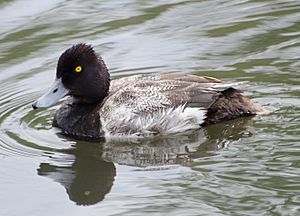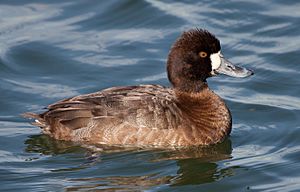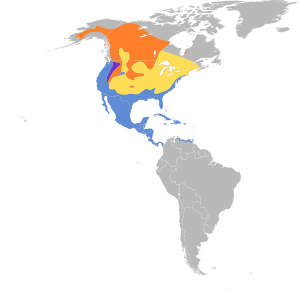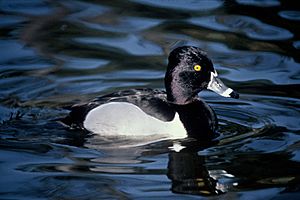Lesser scaup facts for kids
Quick facts for kids Lesser scaup |
|
|---|---|
 |
|
| Adult male | |
 |
|
| Adult female | |
| Conservation status | |
| Scientific classification | |
| Genus: |
Aythya
|
| Species: |
affinis
|
 |
|
| Synonyms | |
|
Fuligula affinis Eyton, 1838 |
|
The lesser scaup (Aythya affinis) is a small North American diving duck. It travels south to Central America for the winter. People sometimes call it the "little bluebill" or "broadbill." This is because of its unique blue bill. The name "scaup" might come from a Scottish word for clams and mussels. It could also come from the female's "scaup" call.
This duck is very similar to the greater scaup. Both are often called "bluebills." The scientific name Aythya comes from an old Greek word for a seabird. Affinis is Latin for "related to," showing its link to the greater scaup.
Contents
What Does the Lesser Scaup Look Like?
Lesser scaup ducks are about 38 to 48 centimeters (15 to 19 inches) long. They usually weigh between 454 and 1089 grams (1 to 2.4 pounds). Males are a bit heavier than females. Their wingspan is about 68 to 78 centimeters (27 to 31 inches).
Adult males have a shiny black head and a small tuft of feathers at the back. Their chest is black, and their back and wings are whitish-grey. The underside of their body is white. Adult females are mostly dark brown. They have a white band at the base of their bill. Young birds look like females but are duller.
Both sexes have white feathers on the inner part of their wings. Their bill is blue-grey with a black tip. Their feet are grey. Males have bright yellow eyes. Females have orange or amber eyes, and young birds have brown eyes. Baby ducks are dark brown on top and pale buff underneath.
These ducks are not very noisy. Females make a "scaup, scaup" call. Males make soft whistles during courtship. Female calls are weaker than those of the greater scaup.
How to Tell Lesser Scaup from Other Ducks
It can be tricky to tell a lesser scaup from a greater scaup. Often, both types of ducks are in the same flock. Females, young birds, and males in their "eclipse plumage" (a duller feather pattern) are the hardest to identify. Greater scaup are usually bigger and heavier.
Lesser scaup females and young birds often have less white around their bill. The bill shape can also help. The lesser scaup's bill has a stronger curve on top. This makes the end of the bill look a bit flat and wide. This is why they are sometimes called "broadbill."
When they fly, look at their wings. Lesser scaup have white feathers only on the inner part of their wings. Greater scaup have white feathers that go further out towards the wingtip.

If you are close, lesser scaup females have darker eyes. Greater scaup males and females have bright yellow eyes. Male lesser scaup in breeding plumage sometimes have a purple shine on their head. Greater scaup males have a green shine. But this can be hard to see depending on the light.
The best way to tell males apart is by their head shape. A greater scaup male usually has a large forehead that slopes smoothly back. A lesser scaup male has a less bulging forehead. Its nape (back of the neck) looks more curved or even angled because of a small crest. These differences are easiest to see when the ducks raise their heads.
Lesser scaup males in breeding plumage can look similar in shape and size to a ring-necked duck. However, the ring-necked duck has black wings, which are very different from the lighter wings of the lesser scaup.
Hybrid Ducks
Sometimes, different duck species can have babies together. These are called hybrids. It can be hard to identify these hybrids, especially in Europe. Hybrids often have a black bill-tip, but scaup ducks only have a black "nail" at the very end of their bill. This difference can help you tell them apart.
Some known hybrids that look like lesser scaup are:
- Hybrids between lesser scaup and ring-necked ducks. They have dark wings but a lighter grey underside than the ring-necked duck.
- Hybrids between lesser scaup and redheads. These ducks have a dull brownish head. Their wings and belly do not contrast much.
Taxonomy: How Scientists Name Them
Scientists use a system called taxonomy to name and classify living things. Two original specimens of the lesser scaup were collected in North America. These specimens are now kept in the World Museum in Liverpool, England. They helped scientists officially describe and name the species in 1838.
Where Do Lesser Scaup Live and Travel?
Lesser scaup ducks breed near lakes and marsh ponds. They live in the northern parts of North America, from Alaska through western Canada. They also breed in western Montana. Many breed in Alaska and the McKenzie River valley.
These ducks migrate south for the winter. They usually travel in groups of 25 to 50 birds. They spend winter on lakes, rivers, and sheltered coastal areas. Their winter homes stretch from the US–Canada border down to northern Colombia. This includes Central America, the West Indies, and Bermuda.
Lesser scaup prefer freshwater or slightly brackish (salty) areas in winter. Unlike greater scaup, they rarely go far offshore. They can even spend winter on lakes in parks if they are not bothered. They start moving north again in April and May.
Sometimes, lesser scaup are seen in places they don't usually live, like western Europe. They have also been seen in Hawaii, Japan, and other distant places.
Ecology: What They Eat and How They Live
Lesser scaup mostly find food by diving underwater. They sift through the mud at the bottom of the water. They mainly eat mollusks like mussels and clams. They also eat seeds and parts of water plants. In winter, they eat more aquatic animals like crustaceans, insects, and small fishes.
Some scaup ducks have changed their migration paths. This is to find zebra mussels in Lake Erie. These mussels were accidentally brought there and have grown a lot. Eating these mussels can be risky for the ducks. This is because mussels can collect pollution from the water.
Life Cycle and Reproduction
Lesser scaup build their nests on the ground near water. They usually hide their nests in thick plants. Sometimes, they nest in small groups. They might even nest near colonies of gulls or terns. Several females might lay eggs in one nest.
Males court the females in their winter homes. Pairs form before or during the spring migration. When nesting begins, the males gather together to molt their feathers. The females are left to incubate the eggs and raise the young alone.
The nest is a shallow dip in the ground. It is lined with plants and soft down feathers. Breeding starts in May, but most ducks nest in June. Females lay about 9 to 11 eggs on average. Sometimes, many more eggs are found in one nest, but these are from more than one female. The female sits on the eggs for about 3 weeks.
The young ducks can fly about 45 to 50 days after hatching. Soon after, they migrate to their winter homes. Lesser scaup can start having their own babies when they are one or two years old. The oldest known lesser scaup lived for over 18 years.
Before their population started to drop, about 57% of lesser scaup nests failed. This was because the female was killed or the eggs were eaten. For nests that hatched successfully, there were about 8 baby ducks on average.
Conservation Status: Are They Safe?
The lesser scaup has the largest population of any diving duck in North America. However, their numbers have been going down since the mid-1980s. They reached their lowest point in the early 2000s.
When scientists count ducks, they often count lesser and greater scaup together. This is because they are hard to tell apart in large groups. Lesser scaup are thought to make up almost 90% of the scaup population in North America. In the 1970s, there were about 6.9 million lesser scaup. By the late 2000s, this number was around 3 million or less.
Even with this decline, the lesser scaup is listed as a species of "Least Concern" by the IUCN. This means they are not currently in danger of disappearing. But if the decline continues, they could become "Near Threatened" or even "Vulnerable."
Scientists are not sure why their numbers are dropping. It seems that fewer nests are successful. Possible reasons include:
- Pollution and habitat destruction, especially where they spend the winter.
- Global warming might be changing their food sources or breeding conditions.
- More greater scaup might be competing with them for food.
However, greater scaup usually eat bigger food items. Also, these two species have lived together for a very long time without major competition problems. Hunting does not seem to be a big reason for the decline either. Their breeding areas are mostly far from human activity, so habitat destruction there is not a major issue.
Images for kids
See also
 In Spanish: Porrón bola para niños
In Spanish: Porrón bola para niños






